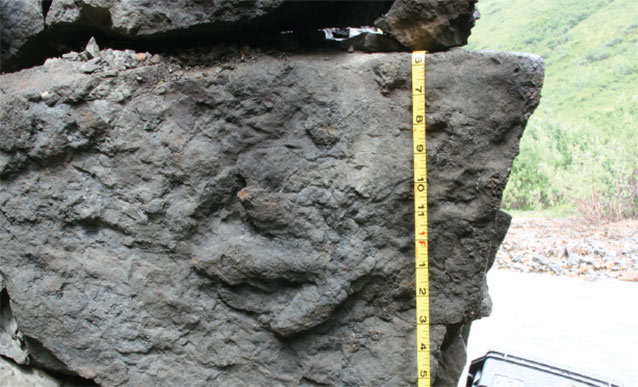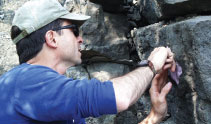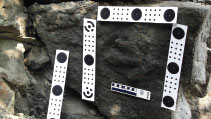
NPS Photo
A three-toed dinosaur track was discovered near Igloo Creek about 35 miles west of the park entrance on June 27, 2005. The fossil, which is roughly 70 million years old, was the first evidence of dinosaurs found in Denali and Interior Alaska.
The Discovery
The dinosaur track was found during a geology field camp in the park. The University of Alaska Fairbanks Department of Geology and Geophysics provides field mapping experiences to students at several locations including Denali. Small groups composed of an instructor and several students work in different study areas each day. On this particular day, Dr. Paul McCarthy, Associate Professor of Geology, casually rested his hand on an outcrop of the Cantwell Formation not far from the Denal Park Road at Igloo Creek. He was explaining to students Susi Tomsich and Jeremiah Drewel that this type of Cretaceous sedimentary rock commonly preserves dinosaur tracks and that they should be alert for them. Almost as if it was staged, Tomsich immediately spied the dinosaur track not far from McCarthy’s gesturing hand and asked, “Like this one?”
The Fossil and the Dinosaur
The first dinosaur fossil found is a cast, i.e., a bump on the rock, not an indentation. The dinosaur left its three-toed footprint in mud. Over time this depression filled with sediments that solidified into rock. The mudstone weathered away and left the cast exposed.
The track cast is about 9 inches (~23 cm) from toe to heel and 6 inches (15 cm) wide. According to Dr. Anthony Fiorillo, Curator of Earth Sciences at the Perot Museum of Nature and Science in Dallas, who has been hunting dinosaur evidence at Denali for more than a decade, the track is from a meat-eating dinosaur. This type of three-toed meat-eater is called a theropod. The details visible on the toes indicate that the track was made by the dinosaur’s right (hind) foot. From the size of the track, Fiorillo estimates the creature was a theropod of modest size—around 10 feet (3 meters) long—and might have weighed 100- 200 lbs (45-90 kg). This group of dinosaurs had small front “arms” and walked on their hind legs. Based on the age of volcanic ash in the rock, the dinosaur track is approximately 70 million years old.
Field Examination of the Track
Fiorillo’s field work in Denali in August 2005 allowed him to document the dinosaur fossil on site and to advise park managers on how to safely remove the block with the track to protect the fossil from erosion or other damage. Accompanying Fiorillo were Brent Breithaupt of the University of Wyoming Geological Museum and then park geologist Phil Brease. On arrival at the site, Fiorillo and Breithaupt bolted from the vehicle and sloshed across Igloo Creek for their first look. Then followed meticulous notetaking, measurements, and photography. Lying awkwardly on the rocky slope, Breithaupt carefully measured all the track’s digits. Before photographing the track from all angles, he stuck black and white rulers to the rock around the fossil with sticky wads. This approach allowed him to generate 3-D computer images that he used to analyze and compare this track to similar ones elsewhere.

Courtesy Dr. Anthony Fiorillo
Significance of the Find
“It’s not necessarily the track itself that’s significant,” said Fiorillo at the time. “It’s where it is that got us excited.” For years, Fiorillo has studied evidence of “polar dinosaurs” along the Colville River on Alaska’s North Slope. Those dinosaurs were probably year-round residents. Fossil remains of dinosaurs have also been found at Aniakchak National Monument (southwest Alaska). The fossil track at Denali was the first evidence of dinosaurs found in Interior Alaska. Since 2005, Fiorillo has found many more dinosaur fossils in Denali, and also in Yukon-Charley Rivers National Preserve and Wrangell-St. Elias National Park and Preserve. Fiorillo believes that all of the eight dinosaur species found in Alaska (as of 2005) migrated from Asia across the Bering Land Bridge and were adapted to winter cold and twilight.
Fiorillo had persistently advocated the search for dinosaur remains in the Cantwell Formation due to its age (Cretaceous) and geological properties (sedimentary rock). The discovery of the first track in this formation provided confirmation and inspiration for ongoing paleontological efforts.

Courtesy Dr. Anthony Fiorillo
Additional Searches in 2005
In 2005, Fiorillo and a field crew also explored two sites on Double Mountain. The sites were ridgetops with slabs or blocks of shales, mudstones, and coarse sandstones that could be scrutinized for fossils. At the first site, they found no dinosaurs, but did find a ridged stem with paired bean-sized nodules (perhaps Equisetum, or horsetail) and fossil leaves and stems. At the second site, they found a theropod footprint similar to the first track—it contained impressions of the foot pads not visible on the first track. They also found bird tracks on buff-colored mudstone and dimples made by feeding birds.
Wildly Successful Searches Since 2005
Since the discovery of the first dinosaur track fossil in 2005, hundreds of sites with thousands of trace fossils have been found, with new fossils finds every year. A park-wide inventory of paleontological resources is underway, and known sites that are at-risk or significant are monitored every other year. These fossils include additional species of dinosaurs—tracks and coprolites (feces)—as well as traces of flying reptiles, birds, clams, worms, and other invertebrates. A more complete ecological picture about life in Denali about 70 million years ago is emerging from the first fossil find and all the ones that have followed.
More Information
Learn more about fossils in Denali
Last updated: October 8, 2021
